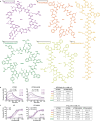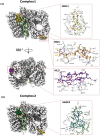This is a preprint.
High-Affinity, Structure-Validated and Selective Macrocyclic Peptide Tools for Chemical Biology Studies of Huntingtin
- PMID: 41030958
- PMCID: PMC12478414
- DOI: 10.1101/2025.08.06.668955
High-Affinity, Structure-Validated and Selective Macrocyclic Peptide Tools for Chemical Biology Studies of Huntingtin
Abstract
Huntington's disease (HD) is a fatal neurodegenerative disorder caused by a CAG repeat expansion in the Huntingtin (HTT) gene, with no disease-modifying therapies currently available. The precise molecular function of the HTT protein is unclear, and the lack of selective chemical tools has limited functional studies. We have identified and characterized macrocyclic peptide binders targeting HTT. These binders exhibit low-nanomolar affinity in vitro and engage distinct HTT and HTT-HAP40 interfaces, as revealed by hydrogen-deuterium exchange mass spectrometry and cryo-electron microscopy. Chemoproteomics confirmed selective binding in cell extracts from wildtype but not HTT-null cell lines. HAP40 consistently and stoichiometrically co-purified with HTT across cell lines, including with HTT variants containing different CAG repeat lengths, highlighting the broad presence of the HTT-HAP40 complex.
Keywords: HAP40; Huntingtin; Huntington’s disease; ligand discovery; peptide macrocycles.
Figures






References
-
- MacDonald M. E.; Ambrose C. M.; Duyao M. P.; Myers R. H.; Lin C.; Srinidhi L.; Barnes G.; Taylor S. A.; James M.; Groot N.; MacFarlane H.; Jenkins B.; Anderson M. A.; Wexler N. S.; Gusella J. F.; Bates G. P.; Baxendale S.; Hummerich H.; Kirby S.; North M.; Youngman S.; Mott R.; Zehetner G.; Sedlacek Z.; Poustka A.; Frischauf A. M.; Lehrach H.; Buckler A. J.; Church D.; Doucette-Stamm L.; O’Donovan M. C.; Riba-Ramirez L.; Shah M.; Stanton V. P.; Strobel S. A.; Draths K. M.; Wales J. L.; Dervan P.; Housman D. E.; Altherr M.; Shiang R.; Thompson L.; Fielder T.; Wasmuth J. J.; Tagle D.; Valdes J.; Elmer L.; Allard M.; Castilla L.; Swaroop M.; Blanchard K.; Collins F. S.; Snell R.; Holloway T.; Gillespie K.; Datson N.; Shaw D.; Harper P. S. A Novel Gene Containing a Trinucleotide Repeat That Is Expanded and Unstable on Huntington’s Disease Chromosomes. The Huntington’s Disease Collaborative Research Group. Cell 1993, 72 (6), 971–983. 10.1016/0092-8674(93)90585-E. - DOI - PubMed
-
- Shelbourne P. F.; Keller-McGandy C.; Bi W. L.; Yoon S.-R.; Dubeau L.; Veitch N. J.; Vonsattel J. P.; Wexler N. S.; US-Venezuela Collaborative Research Group; Arnheim N.; Augood S. J. Triplet Repeat Mutation Length Gains Correlate with Cell-Type Specific Vulnerability in Huntington Disease Brain. Hum. Mol. Genet. 2007, 16 (10), 1133–1142. 10.1093/hmg/ddm054. - DOI - PubMed
-
- Aylward E. H.; Nopoulos P. C.; Ross C. A.; Langbehn D. R.; Pierson R. K.; Mills J. A.; Johnson H. J.; Magnotta V. A.; Juhl A. R.; Paulsen J. S.; PREDICT-HD Investigators and Coordinators of Huntington Study Group. Longitudinal Change in Regional Brain Volumes in Prodromal Huntington Disease. J. Neurol. Neurosurg. Psychiatry 2011, 82 (4), 405–410. 10.1136/jnnp.2010.208264. - DOI - PMC - PubMed
-
- Tabrizi S. J.; Estevez-Fraga C.; van Roon-Mom W. M. C.; Flower M. D.; Scahill R. I.; Wild E. J.; Muñoz-Sanjuan I.; Sampaio C.; Rosser A. E.; Leavitt B. R. Potential Disease-Modifying Therapies for Huntington’s Disease: Lessons Learned and Future Opportunities. Lancet Neurol. 2022, 21 (7), 645–658. 10.1016/S1474-4422(22)00121-1. - DOI - PMC - PubMed
Publication types
LinkOut - more resources
Full Text Sources
